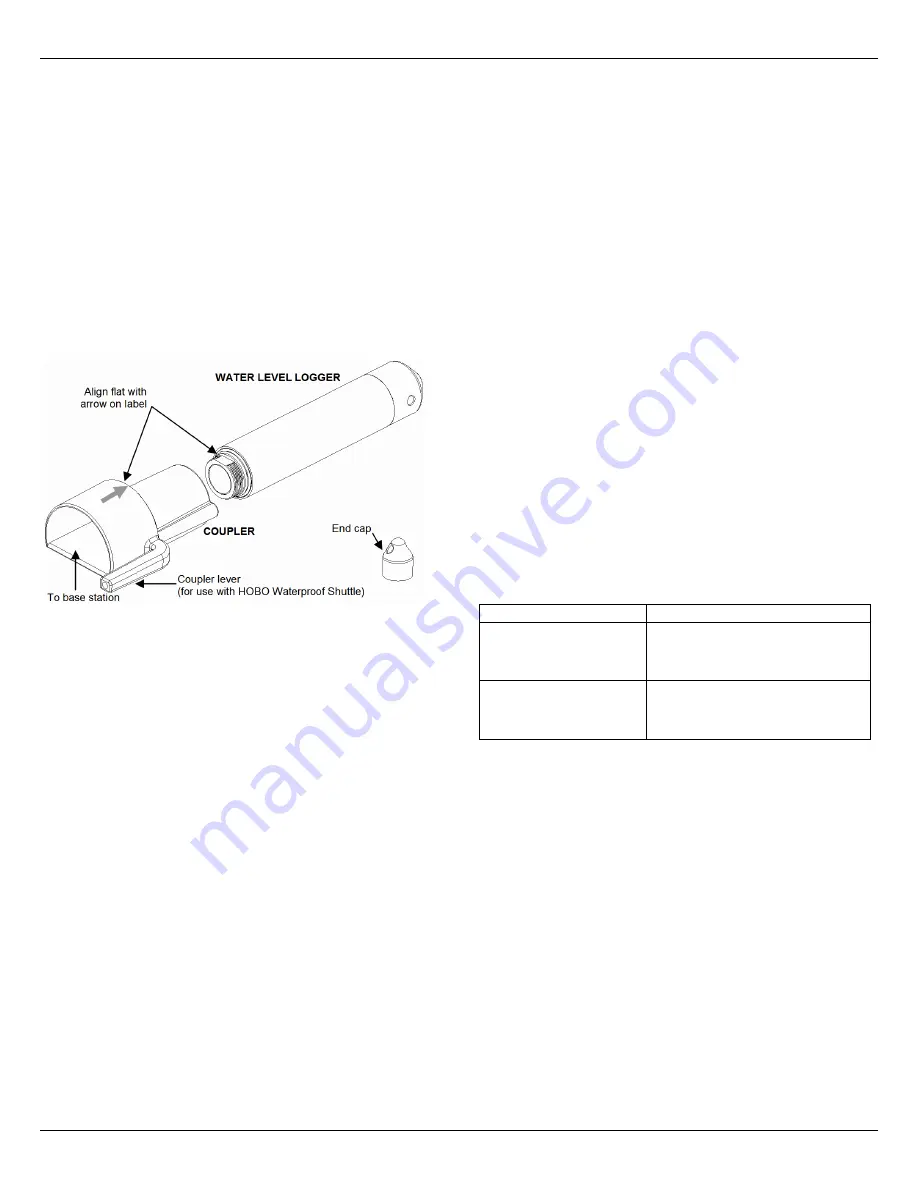
HOBO U20 Water Level Logger
2
Connecting the logger
The HOBO Water Level Logger requires a coupler (Part #
COUPLER2-B) and USB Optic Base Station (Part # BASE-U-4) or
HOBO Waterproof Shuttle (Part # U-DTW-1) to connect to the
computer.
1. Install the logger software on your computer before proceeding.
2. Follow the instructions that came with your base station or shuttle
to attach the base station or shuttle to a USB port on the computer.
3. Unscrew the black plastic end cap from the logger by turning it
counter-clockwise.
4. Attach the coupler to the base station or shuttle, then insert the
logger into the coupler with the flat on the logger aligned with the
arrow on the coupler label. Gently twist the logger to be sure that it
is properly seated in the coupler (it should not turn).
5. If you are using the HOBO Waterproof Shuttle, briefly press the
coupler lever to put the shuttle into base station mode.
6. If the logger has never been connected to the computer before, it
may take a few seconds for the new hardware to be detected by the
computer.
7. Use the logger software to launch the logger.
8. You can check the logger’s status, read out the logger while it
continues to log, stop it manually with the software, or let it record
data until the memory is full.
Refer to the software user’s guide for complete details on launching,
reading out, and viewing data from the logger, including multiple
logging intervals and barometric compensation.
Important: USB communications may not function properly at
temperatures below 0°C (32°F)
or above 50°C (122°F).
Note:
The logger consumes significantly more power when it is
“awake” and connected to a base station or shuttle. To conserve
power, the logger will go into a low-power (sleep) mode if there has
been no communication with your computer for 30 minutes. To wake
up the logger, remove the logger from the coupler, wait a moment,
then re-insert the logger.
Note:
The first time you launch the logger, the deployment number
will be greater than zero. Onset launches the loggers to test them prior
to shipping.
Protecting the logger
•
Important! Do not attempt to open the logger housing!
Unscrewing the titanium nose cone of the logger will cause serious
damage to the pressure sensor and logger electronics. There are no
user serviceable parts inside the case. Contact Onset technical
support if your logger requires servicing.
•
This logger can be damaged by shock.
Always handle the logger
with care. The logger may lose its calibrated accuracy or be
damaged if it is dropped. Use proper packaging when transporting
or shipping the logger.
•
Biofouling and excessive marine growth on the logger will
compromise accuracy. Organisms that grow inside the sensor nose
cone and on the sensor itself can interfere with the sensor’s
operation and eventually make the sensor unusable. If the
deployment area is prone to biofouling, check the logger
periodically for marine growth.
•
Check a materials-compatibility chart before deploying the logger
in locations where untested solvents are present:
−
The logger is shipped with Viton O-rings installed. Viton has an
excellent resistance to most solvents and is suitable for
deployments in water that contain a mixture of most fuels,
solvents and lubricants. However, the Viton O-rings are sensitive
to polar solvents (acetone, ketone), ammonia, and brake fluids.
−
The black acetyl cap is provided to help protect the
communications window. Acetyl is resistant to most solvents,
fuels, and lubricants.
−
The polycarbonate communications window is sealed as an
additional barrier to water and dirt entering the logger housing.
Operation
A light (LED) in the communications window of the logger confirms
logger operation. The following table explains when the logger blinks
during logger operation:
When: The
light:
The logger is logging
Blinks once every one to four seconds (the
shorter the logging interval, the faster the
light blinks); blinks when logging a
sample
The logger is awaiting a start
because it was launched in
Start At Interval or Delayed
Start mode
Blinks once every eight seconds until
logging begins
Sample and event logging
The logger can record two types of data: samples and events. Samples
are the sensor measurements recorded at each logging interval (for
example, the pressure every minute). Events are independent
occurrences triggered by a logger activity, such as Bad Battery or Host
Connected. Events help you determine what was happening while the
logger was logging.
The logger stores 64K of data, and can record over 21,700 samples of
pressure and temperature.
Barometric Compensation
The HOBO Water Level Logger records absolute pressure, which is
later converted to water level readings by the software. In this
application, absolute pressure includes atmospheric pressure and water
head. Atmospheric pressure is nominally 100 kPa (14.5 psi) at sea
level, but changes with weather and altitude.
Left uncompensated, barometric variations could result in errors of
0.6 m (2 ft) or more. To compensate for barometric pressure changes,
you can use another HOBO Water Level Logger as a barometric
reference. The 0-4 m (0-13 ft) HOBO Water Level Logger
(U20-001-04) is a good barometric reference due to its smaller range,




